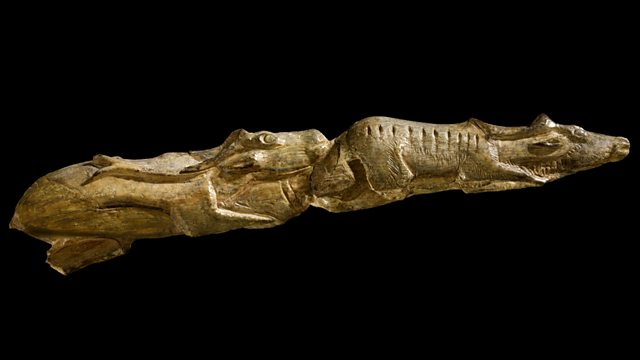Swimming Reindeer
Neil MacGregor continues his new series retelling humanity's history through the objects it's made. Today that object is also one of the earliest works of art.
The Director of the British Museum, Neil MacGregor, retells the history of human development from the first stone axe to the credit card using 100 selected objects from the Museum. Today Neil has chosen an object found in France, dating back 13,000 years. It is a carving of two swimming reindeer and it's not just the likeness that is striking. The creator of this carving was one of the first humans to express their world through art. But why did they do it?
Neil MacGregor tells the story of the Swimming Reindeer, and its place in the history of art and religion with contributions from the Archbishop of Canterbury Dr Rowan Williams and archaelogist Professor Steven Mithen.
Producer: Anthony Denselow
Last on
![]()
Discover more programmes from A History of the World in 100 Objects about art.
About this object
Location: Montastruc, France
Culture: Early People
Period: About 13,000 years-old
Material: Animal Material
Μύ
This sculpture of two swimming reindeer is one of the oldest works of art in the British Museum. It was carved from the tip of a mammoth tusk and made during an extraordinary period of artistic creativity during the last Ice Age. Such works of art could be carried around, bringing images found in the great painted caves of Europe into the daylight. These Ice Age artists were fully modern people with the same mental abilities as humans today.
What was Ice Age art used for?
The artist has depicted the reindeer as they look in autumn. At this time of year the meat, skin and antlers are at their best for use as food, clothing and materials for making equipment. Showing the reindeer swimming may suggest migration or a moment when the animals were easy prey for their human hunters. Was this sculpture a means of communicating with the supernatural world or a charm to guarantee a successful hunt at the start of a bitterly cold Ice Age winter?
Μύ
Did you know?
- When this object was made the sea levels were so low that England was joined to the continent.
Connecting across 13,000 years
By Jill Cook, Curator, British Museum
Μύ
The two reindeer found at Montastruc in 1867 form a figurative sculpture of remarkable naturalism carved with considerable skill and artistry.
Examining the work closely, it is possible to see, gesture by gesture, just how the artist shaped, polished then engraved the animals using flint knives and engraving tools.
Comparing the figures with living reindeer reveals how accurately they are depicted and we are reminded that human society at this time was part of nature. The artist could contour the bodies and shade the skins from knowledge acquired by hunting and butchering reindeer, their main source of food and materials.
Evaluating the aesthetics and spirituality of unknown artists in an extinct culture is much more difficult. While it may make us examine the works closely to collect evidence, we have to recognize that we could not reconstruct Christianity from an image of the Crucifixion although we might be able to construct a view of the society which commissioned it.
Nevertheless, when we see the reindeer in the Museum, we see it as a work of art which touches us deeply and provides a thread connecting us to a spark of human imagination across a 13,000 year time barrier.
Transcript
Broadcasts
- Thu 21 Jan 2010 09:45Βι¶ΉΤΌΕΔ Radio 4 FM
- Thu 21 Jan 2010 19:45Βι¶ΉΤΌΕΔ Radio 4
- Fri 22 Jan 2010 00:30Βι¶ΉΤΌΕΔ Radio 4
- Thu 16 Apr 2020 13:45Βι¶ΉΤΌΕΔ Radio 4
Featured in...
![]()
Art—A History of the World in 100 Objects
A History of the World in 100 Objects - objects related to Art.
Podcast
-
![]()
A History of the World in 100 Objects
Director of the British Museum, Neil MacGregor, retells humanity's history through objects





